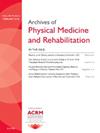通过混合方法评估了解临床医生对在专业护理机构实施高强度阻力康复计划的看法。
IF 3.6
2区 医学
Q1 REHABILITATION
Archives of physical medicine and rehabilitation
Pub Date : 2025-01-01
DOI:10.1016/j.apmr.2024.09.006
引用次数: 0
摘要
目的:评估康复临床医生对旨在促进高强度阻力康复(HIR)的多组分实施计划的看法,以及该计划在加护病房(SNF)中使用的实际意义:评估康复临床医生对旨在促进高强度阻力康复(HIR)的多组分实施计划的观点,以及在专业护理机构(SNF)康复中使用该计划的实际意义:设计:前瞻性聚合混合方法设计:环境:退伍军人事务部下属的八家农村专业护理机构:参与实施计划的物理康复临床医生(物理和职业治疗师、物理和职业治疗助理、娱乐治疗师和运动治疗师)(38 人):干预措施: 临床医生参与多成分实施计划,以促进在临床实践中使用 HIR。项目内容包括临床医师培训(即虚拟教学模块与同步病例讨论)、资源提供(如设备、工作辅助工具)和促进实施(如外部实施促进者支持、分发提示和技巧):主要结果测量指标:干预措施可接受性测量、培训可接受性评分量表、特定研究问卷,以及探讨可接受性、影响、可行性和对工作经验的影响的定性焦点小组:调查问卷显示,实施计划的可接受性和可感知的影响程度较高,可行性也处于中等水平。焦点小组的主题支持这些结果,通过与其他培训的差异化和长期参与解释了高可接受性和影响。促进因素(即团队参与、工作量减少、培训特点)和抑制因素(即培训时间、自定进度的后勤安排、缺乏受保护的时间和空间)从质量上解释了可行性结果。没有报告称培训对临床医生的工作经验产生负面影响:根据 SNF 临床医生的观点,通过提供长期参与和自定进度结构以及内置问责制的实施计划,可以增强积极的 HIR 实施体验。领导和组织的支持对于保护临床医生的时间和空间似乎很重要,因为临床医生在成功促进证据吸收的过程中会遇到相互竞争的优先事项。未来的工作可以评估在农村退伍军人社区医疗机构以外的各种环境中的适用性。本文章由计算机程序翻译,如有差异,请以英文原文为准。
Mixed-Method Evaluation to Understand Clinician Perspectives of a Program to Implement High-Intensity Resistance Rehabilitation Into Skilled Nursing Facilities
Objective
To assess rehabilitation clinicians’ viewpoints regarding a multicomponent implementation program aimed at promoting high-intensity resistance rehabilitation (HIR), as well as practical implications for its use in skilled nursing facility (SNF) rehabilitation.
Design
Prospective convergent mixed-method design.
Setting
Eight rural SNFs within the Department of Veterans Affairs.
Participants
Physical rehabilitation clinicians (physical and occupational therapists, physical and occupational therapy assistants, recreational therapists, and kinesiotherapists) who engaged with the implementation program (n=38).
Interventions
Clinicians engaged with the multicomponent implementation program to promote the use of HIR in clinical practice. The program components included clinician training (i.e., virtual didactic modules with synchronous case discussions), provision of resources (e.g., equipment, job aids), and facilitated implementation (e.g., external implementation facilitator support, distributed tips and tricks).
Main Outcome Measures
Acceptability of Intervention Measure, Training Acceptability Rating Scale, study-specific questionnaires, and qualitative focus groups exploring perceived acceptability, feasibility, and effect on work experience.
Results
Questionnaires revealed high levels of implementation program acceptability and perceived effect, alongside moderate levels of feasibility. Focus group themes supported these findings, explaining high acceptability and effect through differentiation from other trainings and prolonged engagement. Feasibility results were explained qualitatively by facilitatory factors (i.e., team participation, reduced caseloads, training characteristics) and inhibitory factors (i.e., training timing, self-paced scheduling logistics, lack of protected time and space). There was no reported negative effect on clinician work experience.
Conclusions
According to SNF clinician perspectives, a positive HIR implementation experience may be enhanced through implementation programs that provide prolonged engagement and a self-paced structure with built-in accountability. Leadership and organizational support appear important to protect time and space for clinicians who experience competing priorities to successfully facilitate evidence uptake. Future work can evaluate the applicability across various contexts beyond rural VA SNFs.
求助全文
通过发布文献求助,成功后即可免费获取论文全文。
去求助
来源期刊
CiteScore
6.20
自引率
4.70%
发文量
495
审稿时长
38 days
期刊介绍:
The Archives of Physical Medicine and Rehabilitation publishes original, peer-reviewed research and clinical reports on important trends and developments in physical medicine and rehabilitation and related fields. This international journal brings researchers and clinicians authoritative information on the therapeutic utilization of physical, behavioral and pharmaceutical agents in providing comprehensive care for individuals with chronic illness and disabilities.
Archives began publication in 1920, publishes monthly, and is the official journal of the American Congress of Rehabilitation Medicine. Its papers are cited more often than any other rehabilitation journal.

 求助内容:
求助内容: 应助结果提醒方式:
应助结果提醒方式:


